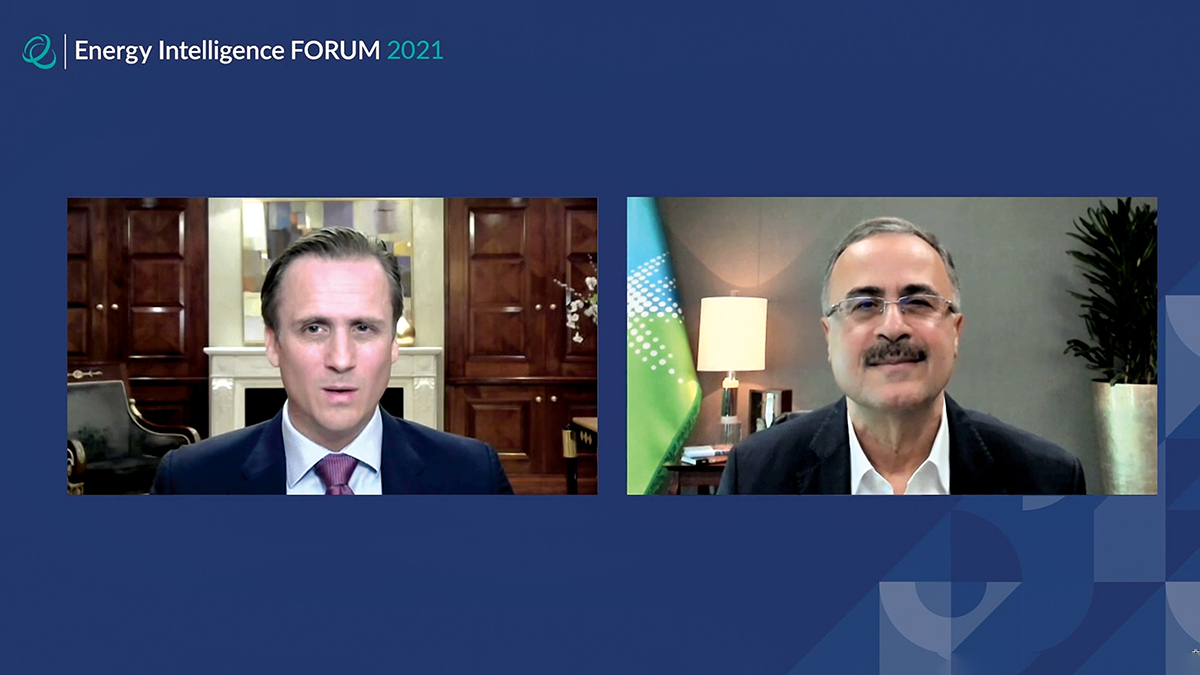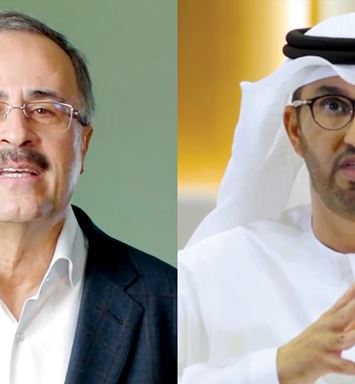Energy Intelligence Forum
CEO addresses Energy Intelligence Forum

Global October 13, 2021
President and CEO Amin Nasser addressed this year’s Energy Intelligence Forum on a variety of topics, including the potential for global oil supply shortages due to industry underinvestment and Aramco’s strategy to respond to the low-carbon energy transition.
President and CEO Amin Nasser addressed this year’s Energy Intelligence Forum on a variety of topics, including the potential for global oil supply shortages due to industry underinvestment and Aramco’s strategy to respond to the low-carbon energy transition.
We’re seeing big spikes in natural gas prices in Europe, in Asia and the US. People are wondering what’s going on. Given that Aramco is the biggest oil supplier to a lot of these markets, we’re hoping to get your insight on what you think is driving this rise in commodity prices. Is this something that’s temporary, driven by speculation?
We see higher demand [in oil]. If you look at the IEA [International Energy Agency] report, we are — for the third quarter— looking at close to 97 million barrels [per day]. By year’s end, we are looking at something around close to 99 million barrels. If you look at the forecast from the IEA for the fourth quarter next year, it’s a little bit over 100 million bbl, so there is higher demand. With the higher demand, we are seeing certain short to mid-term issues pop up, like the energy and the electricity cost in the UK and in Europe, and the shortage of gas. Of course, that had certain impacts on what is happening now. There is some shift that we have seen from gas to liquids especially. In certain markets in Asia, that impact will lift oil demand by an additional almost half a million barrels, shifting from gas to oil. And we are seeing the surplus of inventories is behind us right now, down more than 10% from the five-year average.
Will there be a shortage of spare oil capacity in the market? Will there be a need for more supply from Opec-plus?
We will leave that for Opec-plus to decide, what sort of supply they will be putting in the market. We receive our targets every month from the [Saudi] Ministry of Energy with regard to how much we put in the markets, so they do have their own deliberations with regard to assessing the markets and how much supplies they need to add.
Do you think underinvestment will lead to an inevitable oil shortage, especially given how much the international oil companies are scaling back their investments?
Yes, that’s my concern. As I’ve been saying for the last two to three years, investments are prematurely cut in our industry, we’re seeing that lack of investment in the sector. It’s pressure that we are seeing on major energy companies around the world from their shareholders [and] investors, and that sort of pressure to me is counterintuitive. Capital has become constrained, and several producers are moving away from oil and gas. That in effect lowers supply, and I’m concerned that this trend will continue for the foreseeable future. But the bigger issue is, they are related to the energy transition. The industry does support the transition to having better and cleaner sources of energy. But the transition must ensure there are reliable supplies of energy that people can afford. There is a need for an orderly transition. Pragmatic energy policies are needed and hasty decisions must be avoided as much as possible in order to get back to normality in the business.
How soon do you think we might see a recovery from an investment side and add more supply capacity?
In our sector, a lot of people do not know. It takes time to bring supplies to the markets. Aramco is increasing its maximum sustained capacity from 12 million to 13 million [barrels per day]. That additional 1 million bbl will take a couple of years. It’s not going to come at full capacity at 13 million until 2027. It takes years two to three years between front-end engineering work, and construction would take also another three to four years. So, it will take time to bring additional supplies to the market. We are doing our share in terms of building capacity even though we have adequate spare capacity. Today, we are bringing additional supplies to the market while we’re working on reducing our emissions at the same time. But others in the industry, other energy companies, need to do this.
What is your reaction to the IEA’s net-zero report?
I think the IEA report presented three scenarios. With oil demand in 2050 ranging between 104 and 24 million bbl, it’s a big range. But the focus was mostly on the lower demand case, which is not a realistic picture of the future. The report seems also to reflect a one-sided regional perspective and unfortunately is applied to the entire world. For example, Europe is moving aggressively with the energy transition, but the EU consumes just a little bit above 10% [of crude]. The assumption is that Europe may be able to afford an expensive solution being proposed, but unfortunately most of the developing world won’t be able to come up with [the] additional costs for this energy transition, so affordability is a key priority. But as we see the recent events in Europe, affordability has also become an issue, even in Europe. For the transition to succeed and be smooth, governments and regulators and users and companies need to work together to develop an optimal and practi- cal future energy plan. The way I see it, the report puts a lot of pressure on investors and shareholders and focused on the [low demand] scenario.
What does the growth in demand look like in Asia? Are they asking for lower-carbon cargoes?
We are doing our best to further reduce or eliminate emissions at Saudi Aramco. For example, hydrogen could be a solution, but the markets need to develop further for that to happen at a bigger scale. Currently, the energy transition is slower in the developing world because of high costs and affordability issues. But over time we see that changing, and we also need to be aware of the realities that were highlighted by the IEA and its 2050 Net Zero road map but did not get enough attention. Today, there are 800 million people around the world with no electricity.
Which fields are going to be expanded to add the 1 million b/d increment?
We are doing the front-end engineering right now. In terms of bringing additional capacity when and if required, and that’s what we are doing to get to the 13 million b/d, we will focus on existing fields and will make the appropriate disclosure and announcement when we reach certain project milestones. But the [increment] will come from existing and new fields, so it will be a combination of both.
Mainly offshore fields?
It is. A lot of our resources are in the offshore, so there will be an emphasis on the offshore to develop additional capacity from there.
When will the increment be delivered?
It will not be delivered in one shot. There are different increments coming in phases, but the reaching of the full capacity will be 2027. People do not realize that it is not a switch button that you decide I’m going to bring additional supply. It takes time and effort. The front-end engineering alone takes two years, so I hope we don’t wake up one day with the crisis on our hands because we did not develop the right resources and adequate supplies to meet the world demand.
Can you tell us more about Aramco’s gas development plans?
Today, if you look at our current gas processing capacities, they are around 18 billion standard cubic feet per day. Our unconven- tional gas program will complement our conventional gas program. Jafurah is our largest unconventional project. It is located east of the Ghawar oil field. It’s a very massive structure, we are talking about a 170 by 100 kilometer source rock reservoir, which contains a large quantity of liquid rich gas. One important additional benefit from Jafurah is the extra ethane and NGL [natural gas liquid] from the rich gas it provides. It enhances the profitability, of course, and also [can be used as] feedstock for our chemical business. And most of our current costs are fairly close in developing unconventional gas to North America, while stimulation costs are just below North America. The first increment from Jafurah will be coming on stream in 2025. Then we will ramp up steadily to 2 Bcf/d of sales gas by 2030.
How much gas will come from the first phase of Jafurah?
We’re talking about 200 million-300 million and then it’s ramping up every year until it reaches 2 billion. And as I said, the full capacity will be in 2030.
What are your plans of opening up the gas sector to foreign investors?
The strategy is to eliminate liquid burning in the kingdom, and that will definitely have economic benefits and also help to reduce emissions. So, we have lots of opportunities for collaboration in the midstream and downstream end of the gas business. And if it is of benefit and value, we could certainly explore collaboration opportunities with a range of investors, and that’s basically what we are doing right now. As I said, it’s not going to be only the unconventional gas that we will be developing. There will be others such as non-associated gas that will be developed as well. And we are open for collaboration.
Have there been any developments on your thinking around hydrogen over the past year?
We believe demand for clean hydrogen in the transport sector, electric power generation and industry will increase over time. Two main factors giving us a competitive advantage, particularly in blue hydrogen, are our large gas resources and our strength in our large gas reserves. We are building substantial blue hydrogen capacity as the rate of demand growth is key. The scale will all depend on demand. You know, at the end of the day, clean hydrogen will cost much more than a barrel of oil equivalent or a barrel of gas equivalent. So, the market needs to develop in terms of companies like Saudi Aramco and other energy companies around the world to develop projects at scale. We do have the interest, we do have the capacity, we do have the resources to do that. But right now, we are working with our customers in different markets to see if they have the appetite for big scale projects. That’s what’s important at the end of the day — making sure there is an offtake agreement to build these megaprojects for clean hydrogen.
Caption of the top image: Energy Intelligence president Alex Schindelar put forward probing questions to CEO Amin Nasser.
Reproduced from October 8, 2021 issue of Petroleum Intelligence Weekly, Vol. 60, No. 40, with permission from the publisher, Energy Intelligence Group, for Saudi Aramco. Copyright © 2021 Energy Intelligence Group. All rights reserved.




